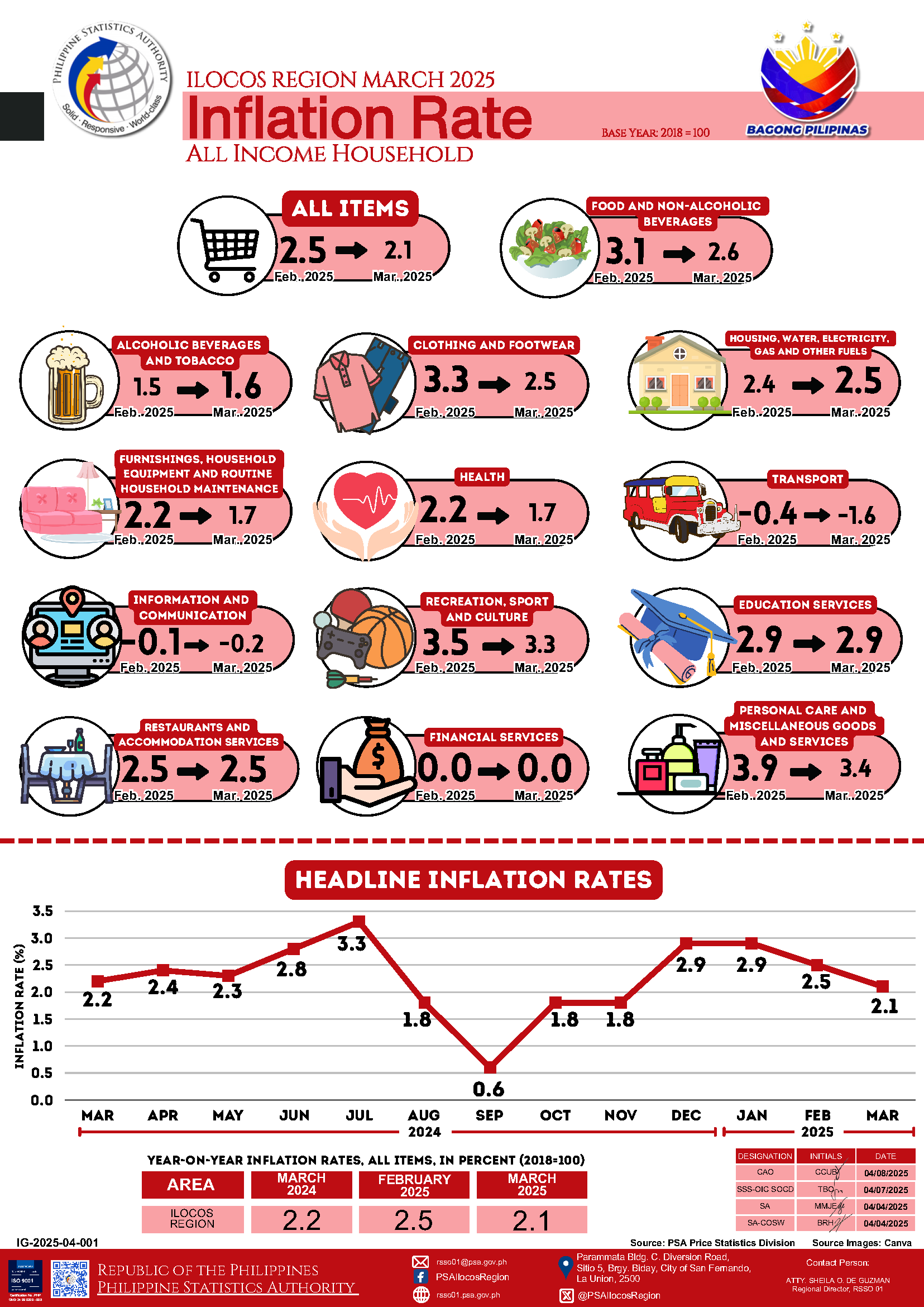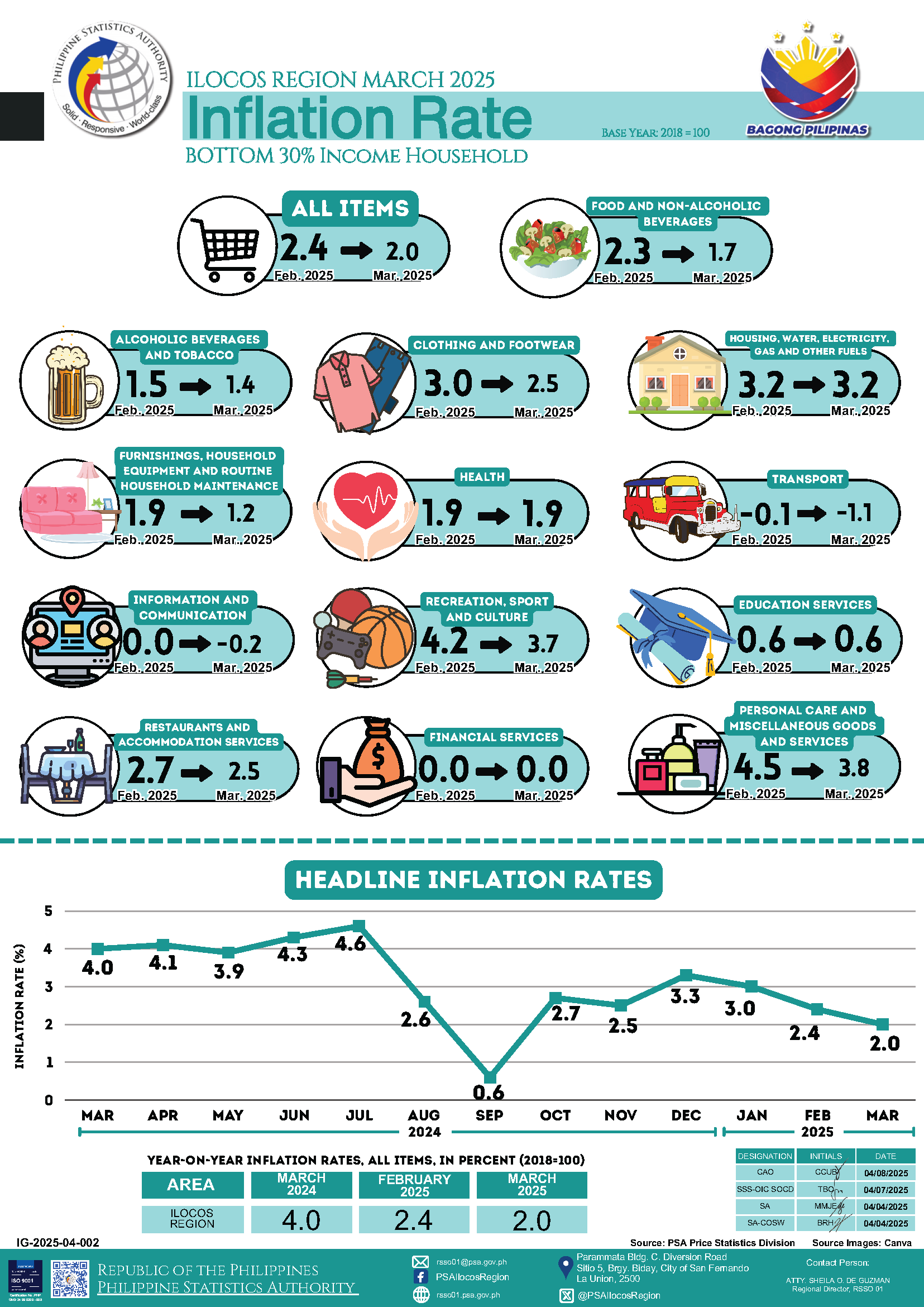La Union’s CPI posted at 115.4 in 3rd Quarter 2023
The average Consumer Price Index (CPI) in La Union in 3rd quarter 2023 was recorded at 115.4. The said figure was 4.8 percentage points higher than the average CPI in the same period of 2022 at 110.6 and 1.9 percentage points higher than the previous quarter’s CPI at 113.5.
La Union’s average CPI of 115.4 in 3rd quarter 2023 means that, on the average, prices of goods and services have increased by 15.4 percent from 2018. This further means that a basket of commodities which can be purchased at PhP100.00 by an average Filipino household in 2018 can be bought at PhP115.40 in 3rd quarter 2023.
The province’s average CPI in 3rd quarter 2022 and 3rd quarter 2023 were lower than Ilocos Region’s CPI which were posted at 116.4 and 121.6, respectively.

The CPI in the province were higher in July, August and September 2023 at 113.3, 116.0 and 116.8, respectively compared with their respective figures in July, August and September last year at 110.7,110.2 and 110.8. (Figure 1)
In 3rd quarter 2023, the highest CPI was posted in September with 116.8, similarly in the same period a year ago, the CPI was also highest in the month of September at 110.8.
La Union’s inflation climbed to 4.3 percent in 3rd Quarter 2023
La Union’s year-on-year headline inflation went up to an average of 4.3 percent in 3rd quarter 2023 from a quarter-ago average of 3.4 percent. (Figure 2)
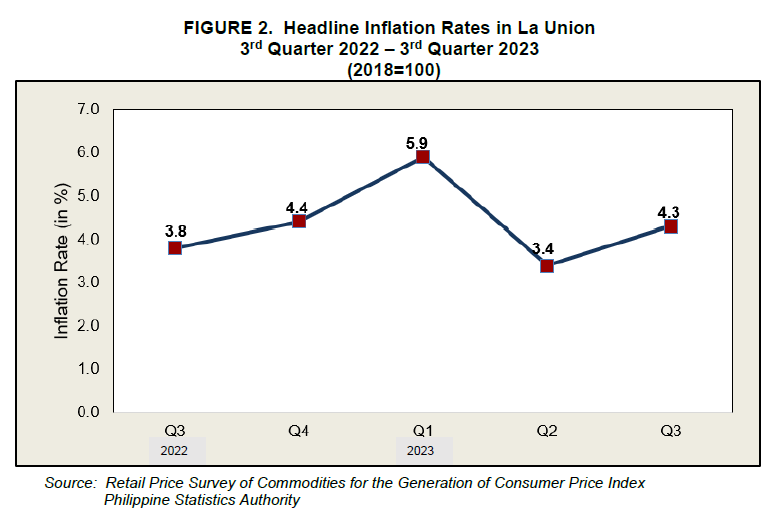
Among the 13 commodity groups, the heavily weighted food and non alcoholic beverages index posted the highest average annual inflation rate at 8.5 percent in 3rd quarter 2023. It was followed by the average inflation in the indices of alcoholic beverages and tobacco at 4.3 percent and housing, water, electricity, gas and other fuels at 3.9 percent.
On the other hand, the lowest average annual inflation during the quarter was seen in the transport index at -1.2 percent. (Figure 3)
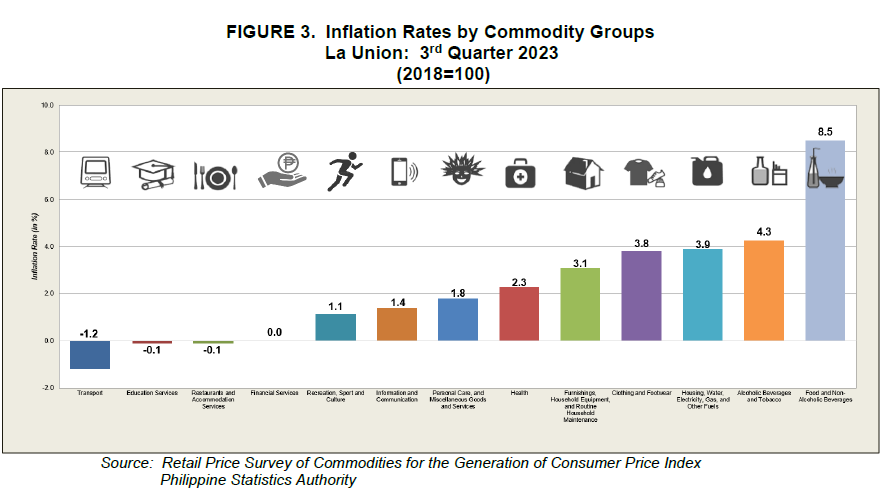
The uptrend in the average annual inflation of the province from 2nd quarter 2023 to 3rd quarter 2023 was primarily contributed by the faster pace in the average annual inflation of the heavily weighted food and non alcoholic beverages index from 6.0 percent to 8.5 percent. Housing, water, electricity, gas and other fuels was the second contributor to the uptrend from an average inflation of 3.1 percent to 3.9 percent. Furnishings, household equipment and routine household maintenance was the third main source of acceleration with an average inflation from 2.7 percent in the previous quarter to 3.1 percent in 3rd quarter 2023. The annual decline in education services index also went up to an average inflation of -0.1 percent in 3rd quarter 2023 from -0.4 percent in 2nd quarter 2023.
On the contrary, lower average annual inflation were recorded in the indices of the following commodity groups in 3rd quarter 2023 than in the previous quarter:
Alcoholic beverages and tobacco, at 4.3 percent from 5.9 percent;
Clothing and footwear, at 3.8 percent from 3.9 percent;
Health, at 2.3 percent from 2.8 percent;
Transport, at -1.2 percent from 0.9 percent;
Recreation, sport and culture, at 1.1 percent from 2.3 percent;
Restaurants and accommodation services, at -0.1 percent from 0.0 percent;
Personal care, and miscellaneous goods and services at 1.8 percent from 3.2 percent.
The average annual inflation in indices of information and communication remained at 1.4 percent. Also, the average annual inflation in the index of financial services also remained at zero growth in 3rd quarter 2023. (Table 1)
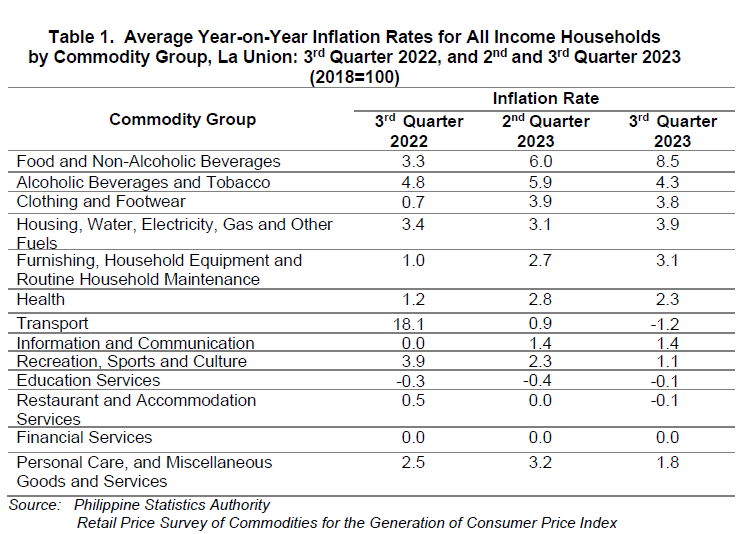
In 3rd quarter 2023, an upward trend was observed in the headline inflation rates of the province with 2.3 percent, 5.3 percent, and 5.4 percent in July, August and September, respectively. In the same quarter a year ago, the annual inflation of the province went down from 4.3 percent in July to 3.3 percent in August but rose in September at 3.8 percent.
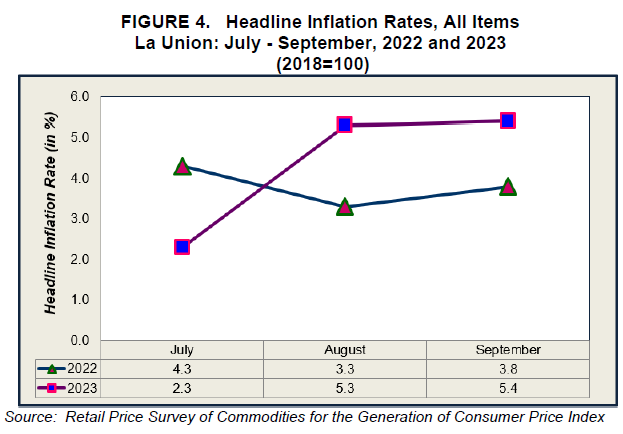
PPP in La Union decreases to PhP0.87 in 3rd Quarter 2023
The average Purchasing Power of the Peso (PPP) in La Union was recorded at PhP0.87 in 3rd quarter 2023, lower than the recorded PPP in the province in 2nd quarter 2023 at PhP0.88. This means that the purchasing capability of PhP1.00 in 2018 decreased by 13 centavos in 3rd quarter 2023. In 3rd quarter 2022, La Union’s average PPP was recorded at PhP0.90.
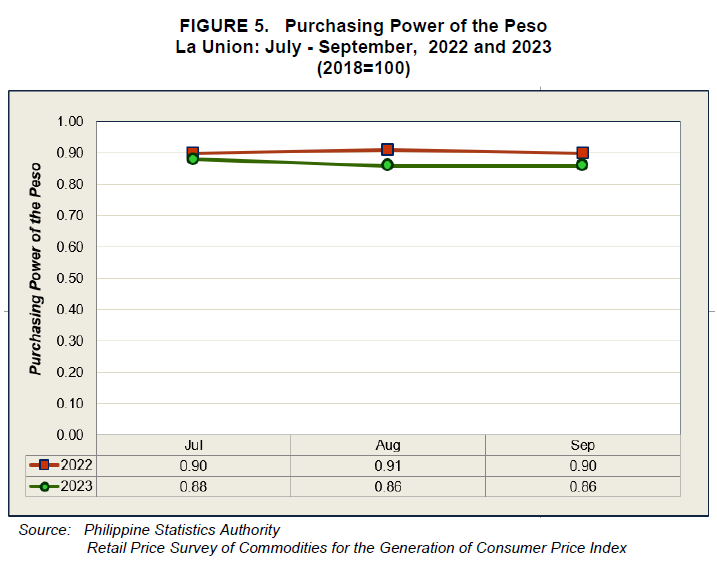
In 3rd quarter 2023, the PPP in the province was recorded at PhP0.88 in July 2023 but declined to PhP0.86 in August 2023 and remained until September 2023. In the same period a year ago, the PPP in the province was higher at PhP0.90 in July, PhP 0.91 in August and PhP 0.91 in September.
La Union’s average PPP in 3rd quarter 2023 was higher than Ilocos Region’s average PPP of PhP0.82. The region’s average PPP a quarter ago was posted at PhP0.83 and in 3rd quarter 2022, at PhP0.86.
TECHNICAL NOTES
The Philippine Statistics Authority (PSA) generates and announces the monthly Consumer Price Index (CPI) based on a nationwide survey of prices for a given basket of goods and services.
The CPI is an indicator of the change in the average prices of goods and services commonly purchased by consumers relative to a base year. It is most widely used in the calculation of inflation rate purchasing power of the peso (PPP). The CPI series also serve as basis for economic analysis, collective bargaining agreements, wage adjustments, and for monitoring the effects of government economic policy on households.
Inflation rate is defined as the annual rate of change or the year-on-year change in the CPI. On the other hand, the PPP is a measure of the real value of the peso in a given period relative to a chosen reference period.
Rebasing of CPI to Base Year 2018 and Adopting the Chained Laspeyres Formula in Index Computation
The PSA has rebased the CPI for all income households to base year 2018, from base year 2012. The methodology of rebasing the CPI to base year 2018 was approved by the PSA Board through the PSA Board Resolution No. 15 Series of 2021.
The PSA has started releasing the 2018-based CPI for All Income Households on 04 February 2022. The rebasing to 2018 is the 12th base period and the 11th rebasing for CPI. This was announced in Press Release Number 2022-01 dated 04 January 2022. The CPI series for all income households for January 2022 onwards shall be 2018-based.
1. Identification of the Base Year
Base period is a reference period, usually a year, at which the index number is set to 100. It is the reference point of the index number series. The CPI is rebased from base year 2012 to base year 2018.
The rebasing of the CPI is done periodically by the PSA due to the following: 1) to ensure that the CPI market basket continues to capture goods and services commonly purchased by households over time; 2) to update expenditure patterns of households; and 3) to synchronize its base year with 2018 base year of the Gross Domestic Product and other indices produced by PSA such as the Producer Price Index (PPI) for Agriculture; PPI for Manufacturing; and Value of Production Index (VaPI), Volume of Production Index (VoPI), and Value of Net Sales Index (VaNSI) for Manufacturing.
The year 2018 was chosen as the next base year because it was the latest year when the Family Income and Expenditure Survey (FIES) results were made available. It is also in accordance with PSA Board Resolution No. 1, Series of 2017-146, which approved the synchronized rebasing of the price indices to base year 2006 and every six (6) years thereafter.
2. Determination of the Market Basket
Market basket refers to a sample of goods and services commonly purchased by the households.
Determining the right market basket is crucial because inadequate representation of the typical basket will give wrong signals as to the behavior of prices, a very important factor in economic planning.
The market basket for the CPI for All Income Households is updated using the results of the 2021 Survey of Key Informants (SKI). The survey, which was undertaken in March 2021, was conducted nationwide to store managers store managers, sellers, or proprietors in order to obtain information on the most commonly purchased goods and availed of services by the households.
The commodities in the 2018-based CPI market basket are grouped according to the 2020 Philippine Classification of Individual Consumption According to Purpose (PCOICOP) which is based on the United Nations COICOP.
3. Determination of the Household Consumption Patterns (Weights)
This activity involves assigning weights to the commodity groups/sub-groups. This reflects the consumption priorities of households and the way they allocate resources to meet their needs. Weight is a value attached to a commodity or group of commodities to indicate the relative importance of that commodity or group of commodities in the market basket.
The weights for the 2018-based CPI were derived from the expenditure data of the 2018 FIES. The weight for each item of expenditure is the proportion of the expenditure of commodity/group of commodities to the total national expenditure. The sum of the weights of the commodity groups at the national level is equal to 100.
The table below shows the comparison of the expenditure weights between the 2012 and 2018-based CPI for the Philippines.
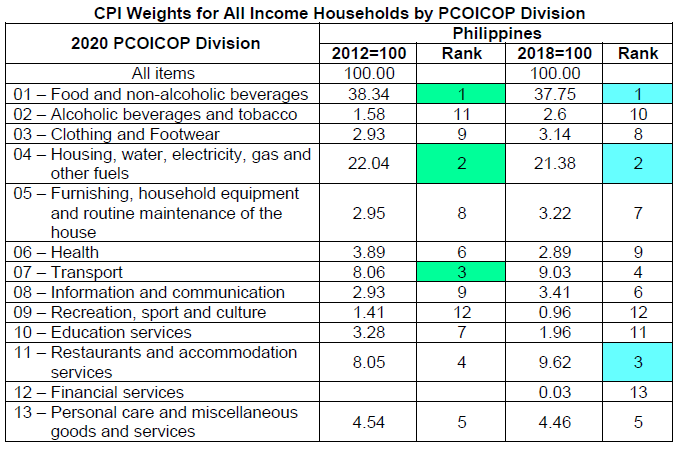
4. Monitoring of Prices of Items in the Market Basket
This involves establishing baseline information for prices of the items in the base year and monitoring the prices of the items on a regular basis. Collection of data for the CPI is done by the provincial staff of the PSA. Except for food, beverage and tobacco (FBT) in the National Capital Region (NCR) and petroleum products which are monitored on a weekly basis, price collection is generally done twice a month. First collection phase is done in the first five days of the month while the second phase is on the 15th to 17th day of the month. Data are collected from the sample outlets (outlets or establishments where prices of commodities/services are collected or quoted) which were chosen using the following criteria:
Popularity of an establishment along the line of goods to be priced – this means the sample outlet is publicly noted in the locality for selling goods included in the CPI market basket and the outlet is patronized by a large segment of the population.
Consistency and completeness of stock
Consistency of stock – the outlet has a constant, steady or regular stock of commodities listed in the CPI price collection forms as well as of those commodities of the same kind and belonging to the same commodity group.
Completeness of stock – the sample outlet carries in its stock many if not all of the items included in the CPI price collection forms relative to the other outlets in the area.
Permanency of outlet – the outlet is an established store or stall in the market area. It should not be an ambulant or transient vendor in order that the collection of data can be done for the succeeding survey rounds.
Geographical location – the outlet is conveniently located and is accessible to the majority of consumers in the area.
5. Index Computation
The 2018-based CPI series uses the same method of computation as the 2012-based CPI series, which is the chained Laspeyres formula.
The PSA employed the weighted arithmetic mean of price relatives and the “Chain” method to provide timely indicators since this method allows the inclusion or exclusion of commodities in the market basket to address the changing consumer taste and preferences and technological changes. Below are the steps in the computation of CPI using the 2018 as the base year:


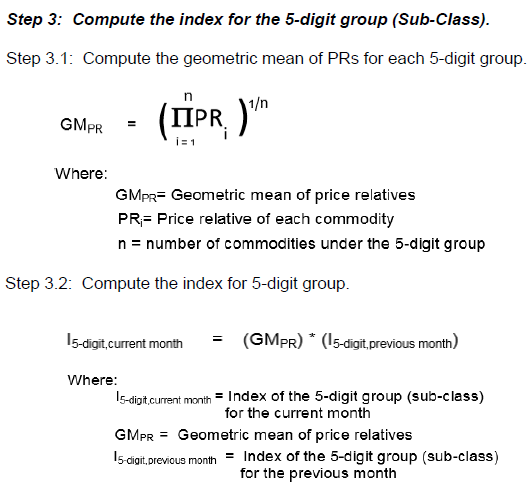


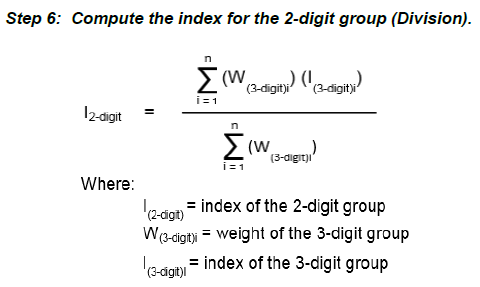
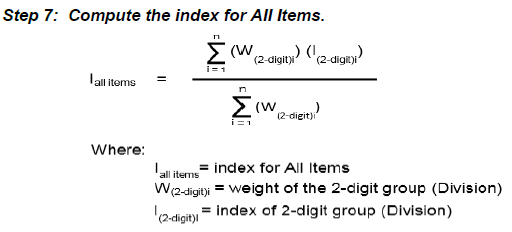
6. Dissemination of Reports
Data are available five days after the reference month which are posted at the PSA website (www.psa.gov.ph). Data series are also uploaded at the OpenSTAT database portal of the PSA website.
Economic Indicators Derived from the CPI
Two important indicators, the inflation rate and PPP, are derived from the CPI which are important in monitoring price stability and the value of the country’s currency.
Inflation Rate is the annual rate of change or the year-on-year change of the CPI expressed in percent. The formula is:

Headline Inflation is the rate of change in the weighted average prices of all goods and services in the CPI basket while Core Inflation refers to the rate of change in the CPI that excludes the following item/commodity groups: rice, corn, fruits and vegetables, and fuel items
The PPP measures the real value of the peso in a given period relative to a chosen reference period. It is computed by getting the reciprocal of the CPI and multiplying the result by 100.

SGD. DANITES E. TEÑIDO, PhD
Chief Statistical Specialist
/MMAAA


